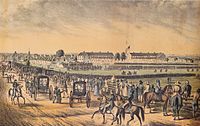
The 115th Infantry Regiment, Maryland Army National Guard was an infantry regiment of the United States Army. It traced its roots back to the American Revolutionary War, although its official U.S. Army lineage begins in 1881. The units to which the 115th Regiment claims lineage served in the Revolutionary War and the Civil War, but the 115th itself was only credited with service in World War I, World War II, and the Global War on Terror. Prior to the reorganization into the 58th Brigade Combat Team, the 1–115th was part of the Third Brigade, 29th Infantry Division (Light). In 2006, the 115th was consolidated (merged) with the 175th Infantry Regiment. As a result of this consolidation, it no longer exists as a separate regiment.
The 5th Maryland Regiment is a designation which has been held by several units over the years, not all of which necessarily share the same lineage and honors. The term "5th Maryland" has most frequently been connected to militia units in Baltimore, even though the first unit to bear the designation was formed in 1776 from volunteers in rural Maryland. The "5th Maryland" designation is the officially recognized traditional designation of the 175th Infantry Regiment, Maryland Army National Guard. This entry refers to the rural 5th Maryland, whose lineage is separate and distinct from the Baltimore 5th Maryland perpetuated by the 175th Infantry Regiment.

George Hume Steuart was a planter in Maryland and an American military officer; he served thirteen years in the United States Army before resigning his commission at the start of the American Civil War. He joined the Confederacy and rose to the rank of brigadier general in the Army of Northern Virginia. Nicknamed "Maryland" to avoid verbal confusion with Virginia cavalryman J.E.B. Stuart, Steuart unsuccessfully promoted the secession of Maryland before and during the conflict. He began the war as a captain of the 1st Maryland Infantry, CSA, and was promoted to colonel after the First Battle of Manassas.
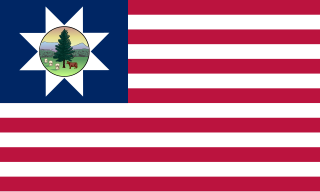
The 12th Vermont Infantry Regiment was a nine months' infantry regiment in the Union Army during the American Civil War. It served in the eastern theater, predominantly in the Defenses of Washington, from October 1862 to July 1863. It was a member of the 2nd Vermont Brigade.

During the American Civil War (1861–1865), Maryland, a slave state, was one of the border states, straddling the South and North. Despite some popular support for the cause of the Confederate States of America, Maryland did not secede during the Civil War. Governor Thomas H. Hicks, despite his early sympathies for the South, helped prevent the state from seceding.

The Maryland Army National Guard is the United States Army component of the U.S. state of Maryland. It is headquartered at the old Fifth Regiment Armory at the intersection of North Howard Street, 29th Division Street, near Martin Luther King, Jr. Boulevard in Baltimore and has additional units assigned and quartered at several regional armories, bases/camps and other facilities across the state.

Bradley Tyler Johnson was an American lawyer, soldier, and writer. Although his home state of Maryland remained in the Union during the American Civil War, it was still considered a Southern state and Confederate sympathies were common, and Johnson served as a brigadier general in the Confederate States Army, leading efforts to raise a Maryland Line in the CSA, and rising to command the 1st Maryland Infantry, CSA.

The 1st Arkansas Infantry (1861–1865) was a Confederate Army infantry regiment during the American Civil War. The regiment was raised in April 1861 by Colonel Thompson B. Flournoy. It moved first to Virginia, but transferred back to Tennessee and served the rest of the war in the western theater, seeing action in the Kentucky, Tennessee and Georgia campaigns. Following its depletion in numbers, the regiment was consolidated several times with other Arkansas regiments, finally merging in 1865 into the 1st Arkansas Consolidated Infantry Regiment. There were three regiments known as "1st Arkansas" during the war. The second unit with the designation of "1st Arkansas" was the 1st Infantry, Arkansas State Troops, which was mustered into Confederate service at Pitman's Ferry, Arkansas, on 23 July 1861, under the command of Colonel Patrick Cleburne; this unit was eventually redesignated as the 15th Arkansas Volunteer Infantry. The third unit bearing the title "1st Arkansas" was the 1st Arkansas Volunteer Infantry, which served with the Union Army.

George Hume Steuart (1790–1867) was a United States general who fought during the War of 1812, and later joined the Confederate States of America during the Civil War. His military career began in 1814 when, as a captain, he raised a company of Maryland volunteers, leading them at both the Battle of Bladensberg and the Battle of North Point, where he was wounded. After the war he rose to become major general and commander-in-chief of the First Light Division, Maryland Militia.

The Washington Blues were a company of Maryland Volunteers which saw action during the Battle of Bladensburg and the Battle of North Point, during the War of 1812.
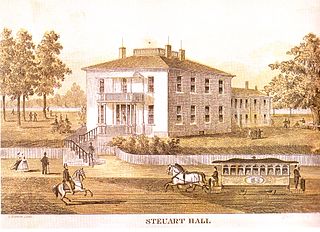
"Maryland Square", later known as "Steuart Hall", was a mansion owned by the Steuart family from 1795 to 1861, located on the western outskirts of Baltimore, Maryland, at the present-day junction of West Baltimore and Monroe streets. In the first year of the American Civil War, the property was confiscated by the United States Federal Government as its owner, George H. Steuart, a former United States Army officer, had resigned his commission to fight in the Confederate Army, in the Army of Northern Virginia as a brigadier general.
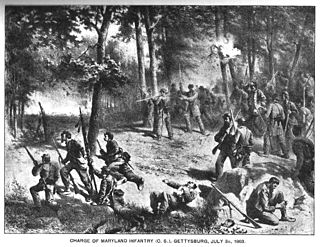
The Maryland Line in the Army of the Confederate States of America was made up of volunteers from Maryland who, despite their home state remaining in the Union, fought for the Confederate States of America during the American Civil War. Of approximately 25,000 Marylanders who volunteered, most fought in the Army of Northern Virginia, and it was not until late in 1863 that a Maryland Line in the CSA was formally created. However, by this late stage in the war, few men wished to leave the units they had fought alongside for more than two years, and the exiles' dream of an independent Maryland Line in the Confederate army would never be fully realized.
Like other border states, Maryland found herself in a difficult position at the start of the American Civil War, with loyalties divided between North and South. Although Maryland herself remained in the Union, Maryland militia units fought on both sides of the Civil War. Many militia members travelled south at the start of the war, crossing the Potomac River to join the Confederate Army of Northern Virginia.

The 1st Maryland Infantry Regiment was a regiment of the Confederate army, formed shortly after the commencement of the American Civil War in April 1861. The unit was made up of volunteers from Maryland who, despite their home state remaining in the Union during the war, chose instead to fight for the Confederacy. The regiment saw action at the First Battle of Manassas, in the Shenandoah Valley Campaign, and in the Peninsular Campaign. It was mustered out of service in August 1862, its initial term of duty having expired. Many of its members, unable or unwilling to return to Union-occupied Maryland, went on to join a new regiment, the 2nd Maryland Infantry, CSA, which was formed in its place.
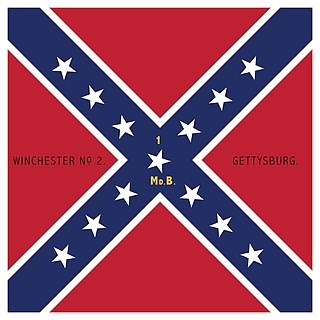
The 2nd Maryland Infantry Regiment, was a Confederate infantry regiment made up of volunteers from Maryland who, despite their home state remaining loyal to the Union during the American Civil War, chose instead to fight for the Confederacy. The regiment was largely made up of volunteers from the 1st Maryland Infantry, CSA, which was disbanded in August 1862, its initial term of duty having expired. They saw action at many of the fiercest battles of the Civil War, taking part in the brutal fighting at Culp's Hill at the Battle of Gettysburg. The unit suffered such severe casualties during the war that, by the time of General Robert E. Lee's surrender at Appomattox Court House on April 9, 1865, only around forty men remained.

The units of the Arkansas Militia in the Civil War to which the current Arkansas National Guard has a connection include the Arkansas State Militia, Home Guard, and State Troop regiments raised by the State of Arkansas. Like most of the United States, Arkansas had an organized militia system before the American Civil War. State law required military service of most male inhabitants of a certain age. Following the War with Mexico, the Arkansas militia experienced a decline, but as sectional frictions between the north and south began to build in the late 1850s the militia experienced a revival. By 1860 the state's militia consisted of 62 regiments divided into eight brigades, which comprised an eastern division and a western division. New regiments were added as the militia organization developed. Additionally, many counties and cities raised uniformed volunteer companies, which drilled more often and were better equipped than the un-uniformed militia. These volunteer companies were instrumental in the seizure of federal installations at Little Rock and Fort Smith, beginning in February 1861.

The 175th Infantry Regiment is an infantry regiment of the Maryland Army National Guard. It is one of several National Guard units with colonial roots and campaign credit for the War of 1812.
The 138th Infantry Regiment is an infantry regiment of the United States Army and the Missouri National Guard headquartered in Kansas City, Missouri.
The following list is a bibliography of American Civil War Confederate military unit histories and are generally available through inter-library loan. More details on each book are available at WorldCat. For an overall national view, see Bibliography of the American Civil War. For histories of the Union, see Bibliography of American Civil War Union military unit histories. For a guide to web sources see: Carter, Alice E.; Jensen, Richard. The Civil War on the Web: A Guide to the Very Best Sites—Completely Revised and Updated (2003).
